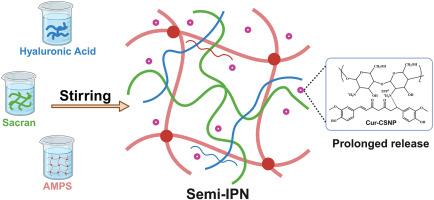Sacran-based semi-IPN hydrogel with prolonged drug release from curcumin/chitosan nanoparticle and broad bioactivity
IF 4.9
3区 医学
Q1 PHARMACOLOGY & PHARMACY
Journal of Drug Delivery Science and Technology
Pub Date : 2025-09-03
DOI:10.1016/j.jddst.2025.107485
引用次数: 0
Abstract
Chronic inflammatory diseases and oxidative stress-related conditions remain challenging to manage due to the poor bioavailability, rapid degradation, and systemic toxicity associated with conventional therapies. Curcumin, a natural polyphenol with potent antioxidant and anti-inflammatory properties, holds therapeutic promise but is limited by poor solubility and instability under physiological conditions. Here, we developed a chemically and physically integrated, semi-interpenetrating network (semi-IPN) hydrogel platform for localized and sustained curcumin oral delivery. The hydrogel is composed of poly (2-acrylamido-2-methyl-1-propanesulfonic acid) (PAMPS), hyaluronic acid (HA), and the supergiant glycosaminoglycanoid, sacran, forming a highly anionic, viscoelastic, highly hydrated and mechanically robust polyelectrolyte network. Curcumin was pre-encapsulated within chitosan/tripolyphosphate nanoparticles (Cur-CSNPs), which were physically entrapped in the hydrogel to confer hierarchical control over drug diffusion. The composite hydrogel exhibited primarily pH-independent, sustained curcumin release, with enhanced swelling capacity and structural integrity attributed to the synergistic interplay of its macromolecular components. In vitro studies demonstrated potent and sustained antioxidant and antibacterial activities against Staphylococcus aureus and Escherichia coli, along with high cytocompatibility in RAW 264.7 macrophages. This macromolecularly engineered, biofunctional hydrogel presents a promising delivery platform for plant-derived bioactives, combining network design with hierarchical drug encapsulation to address key challenges in inflammation-targeted therapeutics.

具有姜黄素/壳聚糖纳米颗粒缓释药物和广泛生物活性的沙克兰基半ipn水凝胶
由于传统疗法的生物利用度差、降解快和全身毒性,慢性炎症性疾病和氧化应激相关疾病仍然具有挑战性。姜黄素是一种天然多酚,具有有效的抗氧化和抗炎特性,具有治疗前景,但受生理条件下溶解度差和不稳定性的限制。在这里,我们开发了一种化学和物理集成,半互穿网络(半ipn)水凝胶平台,用于局部和持续口服姜黄素。该水凝胶由聚(2-丙烯酰胺-2-甲基-1-丙磺酸)(PAMPS)、透明质酸(HA)和超大糖胺类糖聚糖(sacran)组成,形成了高阴离子、粘弹性、高水合和机械坚固的聚电解质网络。姜黄素被预先封装在壳聚糖/三聚磷酸纳米颗粒(curc - csnp)中,这些纳米颗粒被物理包裹在水凝胶中,从而对药物扩散进行分层控制。复合水凝胶主要表现为不受ph影响的姜黄素持续释放,由于其大分子组分的协同相互作用,具有增强的溶胀能力和结构完整性。体外研究表明,对金黄色葡萄球菌和大肠杆菌具有持续有效的抗氧化和抗菌活性,并且在RAW 264.7巨噬细胞中具有高细胞相容性。这种大分子工程的生物功能水凝胶为植物源性生物活性物质提供了一个有前途的输送平台,将网络设计与分层药物包封相结合,以解决炎症靶向治疗的关键挑战。
本文章由计算机程序翻译,如有差异,请以英文原文为准。
求助全文
约1分钟内获得全文
求助全文
来源期刊
CiteScore
8.00
自引率
8.00%
发文量
879
审稿时长
94 days
期刊介绍:
The Journal of Drug Delivery Science and Technology is an international journal devoted to drug delivery and pharmaceutical technology. The journal covers all innovative aspects of all pharmaceutical dosage forms and the most advanced research on controlled release, bioavailability and drug absorption, nanomedicines, gene delivery, tissue engineering, etc. Hot topics, related to manufacturing processes and quality control, are also welcomed.

 求助内容:
求助内容: 应助结果提醒方式:
应助结果提醒方式:


